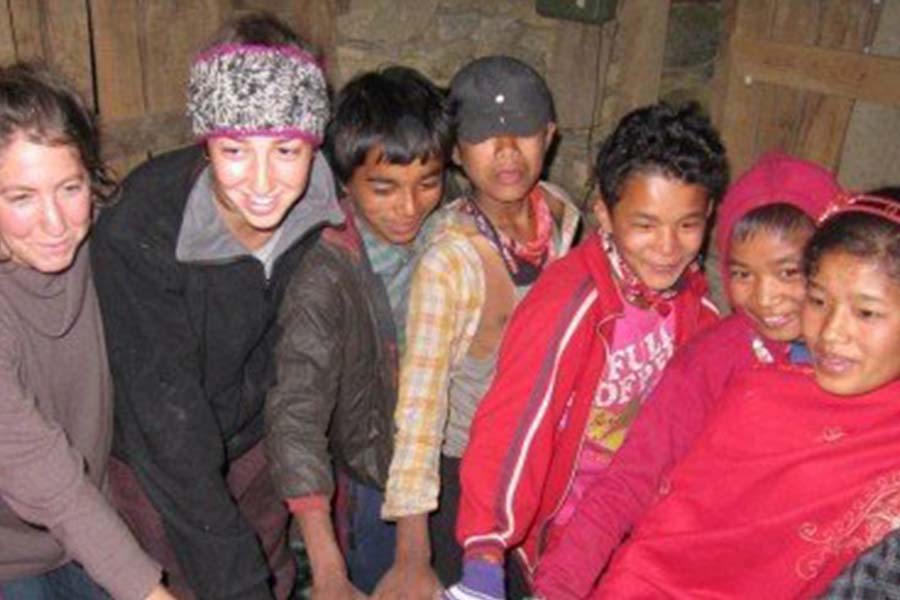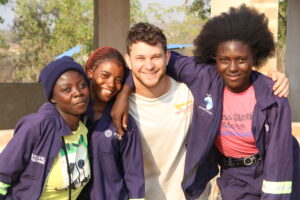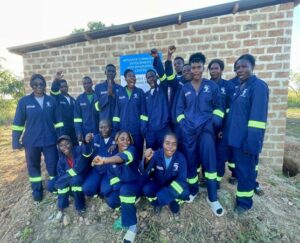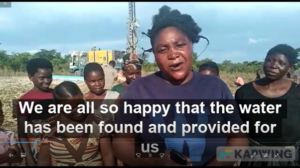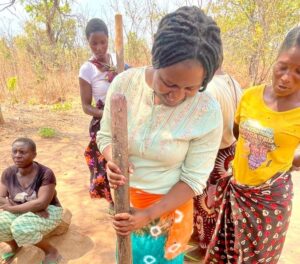* This post was originally published in Repair Labs Service-Learning Journal on February 27th, 2012.
The dilemma that this article explores is one that is central to all organizations that bring Western volunteers, often unskilled, to developing countries for relatively short terms of service, especially when the organizational strategy involves working directly with impoverished populations on a community level. How can these volunteers, who arrive with no knowledge of the local language or culture, be used effectively to create positive change and transformation in impoverished villages? Tevel b’Tzedek, an Israeli based NGO, was founded in 2007 in order to create a Jewish-Israeli platform for engagement with the crucial and enormous global challenges of extreme poverty and environmental devastation. More than 400 Israelis and Jews, most in their 20’s, are graduates of our programs in Haiti and Nepal.
In particular, this article explores dilemmas that have emerged from our four month learning service program in Nepal, that combines one month of intensive study of the Jewish social justice tradition, global economic and environmental issues, and Nepali language and culture with three months of service working directly with impoverished communities. TbT’s answer to the challenge of using relatively short term volunteers within projects aimed at long term sustainable development is to embed the volunteers in a much longer, ongoing process led by local staff and the local community. In brief, TbT takes a multidimensional community development approach, working simultaneously on community empowerment, income generation (usually through agriculture), health and sanitation, literacy and youth and education in a three to five year process. Within this broader context the volunteers can make a significant contribution.
Before detailing our approach, I take a step backward and examine the problems with our initial strategy, which we eventually rejected.
Internships in Local NGOs versus Long-Term Partnership Projects
- With our first four cohorts, our strategy was to place participants as interns with local NGOs. We provided the educational component of the service-learning program, as well as emotional and logistical support, but our participants’ service was with local organizations in tasks set by them and under their supervision. Although this strategy can yield good results, we discovered a number of drawbacks that led us to rethink our approach:
- Quality of NGOs: It is very hard to judge the quality of an NGO from the outside. Even after doing due diligence, visiting, and seeing projects in action, we discovered that there were often large gaps between the NGOs’ declared intentions and what they were actually doing on the ground.
- Job placements within the NGO: The logical place for most local NGOs to use English-speaking interns is in the NGO office, writing project proposals or reports or working on the website. Although these tasks are certainly important and significant, they are office jobs, which often unfold within a hierarchy that is not necessarily well understood by the interns. Moreover, they take place at a remove from the exigencies of the villagers and slum-dwellers who are our target population. Participants who interned at NGOs who were not given meaningful assignments as promised were often disheartened by the experience.
- Inefficient use of interns: The strategy of placing interns with local NGOs puts the burden of sustainable use of an ongoing chain of relatively short-term volunteers on each NGO. The NGO, whatever it declares publicly, may continue to accept volunteers in the hopes of receiving other kinds of help—usually financial—from the mother organization or from contacts it imagines the volunteer must possess, but it is often hard-pressed to use the volunteers for day-to-day tasks in an efficient fashion.
- Tevel b’Tzedek’s (TbT’s) move away from internships in local NGOs toward a more robust involvement in building long-term partnership projects was motivated by all of these concerns—and in particular by our desire to find a path through which our participants could be directly involved in work with impoverished communities, rather than in office situations. We came to believe in the great potential for wiping out poverty by helping organize the collective strengths of communities. One more factor moved us: our growing conviction that we could do so much more if we used the various resources and powers at our command to help communities directly—in partnership, of course, with local organizations and the community itself. If we were cultivating a long-term presence on the ground in Nepal—which we thought was necessary even for our educational purposes—and if we possessed technical, intellectual, and other human resources, as well as financial ones, that could together help us make a powerful and positive impact on the lives of many people living in dire poverty, then it seemed to us that it was our responsibility as well as our privilege to do so.
The following are some of the principles and guidelines we have developed to successfully integrate volunteers into long-term sustainable and community based development.
Where to work—villages and communities that are in the midst of rapid change
All of the communities in which TbT is working are in a state of flux and are experiencing various degrees of instability. This rapid change characterizes not only the slum area in Kathmandu, our city project where we focus on migrant families—especially women, children, and working teenagers—but also rural villages. These villages do not grow enough food to sustain their population for more than six to eight months of the year. Many of the young men and some of the young women have left the area to work in Kathmandu, India, or in the Gulf States. As a result, a cash economy has been introduced within the villages, widening gaps between rich and poor. A violent ten-year Maoist rebellion whose military aspect ended in 2006 but whose repercussions still dominate Nepal’s politics thoroughly shook the prevailing caste and gender hierarchies, though without decisively breaking the hold of the upper castes on the land and resources. Community leadership has been challenged and in some villages has broken down. In small regional centers near the villages, signs for Pepsi and Coca Cola or other corporate products dominate the landscape—symbolic of the rapid intrusion of consumer culture into the village environment and ethos. Most of the villagers are illiterate or semi-literate and have no access to Internet, but radio and television are part of their lives. In short, the villages in which we work are challenged by changes that are often far beyond their ability to control and that are connected to global economics, trends, and events.
Within this context, our volunteers—if supported in the right way—can do significant work by bringing knowledge, attention, and a sense of possibility that can increase these villages’ capacity to cope with change.
How to Prepare to Work: Inculcate Questioning and humility
Our volunteers go through a month-long training in Nepali language, culture, history, and politics (as well as, more broadly, in globalization, poverty, and Judaism and social justice). Classes on the etiquette and customs of the village or community are offered as well. Each volunteer receives some 25–30 hours of language instruction alone. Although of course this instruction only provides a beginning toward fluency, it is enough to connect the volunteers to the community by demonstrating the effort they have made to penetrate the Nepali reality.
This educational effort is designed to introduce a dimension of humility and self-questioning into the volunteering attitude. In the training, emphasis is placed on the ethical challenges and dilemmas of the work, including questioning our “right” to introduce new ideas into the village context and examining how the presence of volunteers affects the village. The volunteers understand themselves as going into the community to learn as well as to teach; they internalize the notion that it is not only the villages or slum communities that must ultimately change to survive but also that their home society must also change to create a more just and beautiful human future.
How to work: hire Full-time, Long-term Local and International staff
Although short-term volunteers make significant contributions to our programs, our programs do not depend on them. Perhaps the most important insight we have learned is the importance of full-time local staff. There are now 18 Nepali staff members engaged full time in development work; they include professionals in the fields of agriculture, youth, women, community theater, and early childhood education. Most live with the villagers in the regions in which we work; others who have expertise that is needed in all of our field locations live in Kathmandu but travel often to each site. The Nepali staff have a dual role: to advance the ongoing project that stretches over the course of three to five years and to help mediate and integrate the volunteers in their role within the project. Thus the staff work with volunteers when they are in the field, but also continue to work with the community even when there are no volunteers. For example, the agriculture professionals, in addition to training farmers in the TbT demonstration farms, also go to see the progress of the farmers in their own fields and are always available for consultation. It is important to invest in the Nepali staff—providing them with trainings and seminars and continuously involving them in developing our long-term goals, in brainstorming, and in administration. We have also found it helpful to cross-pollinate Nepali and Israeli ideas—not only bringing experts to Nepal but also bringing Nepali staff to Israel. One of TbT’s regional directors will be starting a master’s program at Hebrew University in Community-Based International Development—a program that TbT was instrumental in creating.
In addition to this extensive local staff, we also use a much smaller international (usually but not always Israeli) staff. The international staff help create community in each new cohort and tend to the emotional and physical needs of the participants; they also serve as liaisons between the Nepali staff and the Israeli and international volunteers, especially when the relationships are in the beginning stages.
Embed the Program within the Community and Region
Over the course of the past few years we have also learned how important it is to work closely in partnership with regional NGOs, with community leadership, and with the Nepali government. We have always worked in close conjunction with local or community NGOs, but we are learning to bring together all the different groups working in the area. For example, during this past summer we organized meetings of local NGOs, community representatives (including from women’s and youth groups), and government officials in each of our service areas. At each meeting we received feedback on our program and the work of our staff and volunteers, and the community helped us understand their aspirations and priorities. We pay special attention to connecting the community with regional government offices that can provide sustainable help long after we have left the area.
Facilitate Teamwork and Community
There is no rule that says that volunteering in an impoverished community must be a lonely or individualistic experience. That is why, instead of sending single volunteers into organizations or villages as did the Peace Corps in the 1960s, TbT sends in teams of volunteers. Teamwork means that planning, assessment and feedback, division of labor, and team activities become part of the volunteering experience. Together, a group of volunteers, especially when supported by local staff, can overcome many logistical, cultural, and emotional barriers that cannot be met by volunteers operating alone.
Ensure that Volunteers can play a crucial role
With the Nepali staff, the local organizations, and community leadership playing such an important role, what is the role of volunteers? Embraced within concentric circles of permanent staff and community, volunteers can indeed play a crucial role.
Volunteers Help Mobilize the Community
The most important lesson we have learned about community transformation is that techniques, knowledge, social structures, and even the influx of new resources are only effective to the extent that they are absorbed and “owned” by the community. Often, the first step in this process is creating excitement around the possibility of change. Here, the volunteers can play a crucial role. Villagers who have had virtually no contact with Westerners, yet intuitively understand how much Western technology, culture, and policies influence and shape the world, are excited and curious about the volunteers and appreciative of how far they have come to share their knowledge. The groups we work with are from low castes and often perceive the presence and interest of Westerners as a counterbalance to the power of the dominant ethnic groups.
Thus the first contribution of the volunteers is to create interest and encourage villagers to attend the community programs. Tevel b’Tzedek places teams of Nepali staff and Israeli or North American volunteers together to run women’s groups, youth groups, child clubs, teenage girls groups, and men’s groups—groups for virtually every part of the village or community population. One local NGO told us that it had been trying unsuccessfully for years to form women’s groups in one particular village; when our volunteers began to co-lead the groups, the interest was so great that nearly every adult woman began to attend. These women’s groups were the catalyst for literacy classes and for the installation, for the first time, of toilets (bio-gas) in every home in the village. Although this kind of excitement can wear out after a while, it is our experience that the volunteers boost attendance across the board and in this way create opportunities for community mobilization.
Similarly, school attendance had always been a problem in one of the villages where we placed volunteers. When our volunteers began making rounds early in the morning to pick children up on the virtual school bus they created—a long rope of which all the children took hold—attendance shot up. Several teenage girls who had dropped out of school a few years earlier returned to school—and ran the school “bus” when volunteers were not present. In another village, volunteers made home visits to the parents of elementary school children and discussed with them the importance of regular school attendance; as a result, children who had been chronically absent, often because they were pulled into household or farm responsibilities, returned to school. In fact, in a double-edged illustration of the power of Western volunteers, in one of the villages in which our participants, in addition to other duties, taught extracurricular activities in an elementary school (we are careful to ensure that our volunteers do not take the place of Nepali teachers in the classroom), a private school in the area closed its doors. If there are Western volunteers at the public school, the villagers surmised, why pay for private school? This is just an example of the perhaps unjustified respect for Western education that helps mobilize communities.
Volunteers Bring Specific Kinds of Knowledge Even if They Are Not “Experts”
Our volunteers range in age—from 20 through 70—and in experience. Although most are between the ages of 20 and 25 and are not yet highly trained in skills typically needed in developing countries, such as nursing, medicine, agriculture, or engineering, they bring with them many kinds of specific skills. Many Israeli volunteers, for example, have years of experience in leading groups of young people, both in youth movements and in the army (as teachers or other types of instructors). The synergy between Israeli volunteers and Nepali youth workers from our staff and local NGOs has led to a new model of youth work, in which Israeli youth movement methods have merged with the Nepali understanding of youth empowerment. Israeli and Jewish young adults from other countries also contribute skills in many other areas—theater, art, music, photography, dance, computers, and the social and hard sciences. These skills and knowledge can become effective and exciting components of a larger program of youth empowerment and enrichment that is held together by permanent staff. In addition, college- and army-trained volunteers often have the capacity to acquire new knowledge at a fast pace and can thus, with guidance, master specific curricula (whether in public health, children’s or worker’s rights, or organic agriculture) and help lead groups with the Nepali staff. Volunteers also often have research and analysis capacities that locals may not have developed and so can play a role within a larger plan.
Volunteers Bring Enthusiasm and Keep the Nepali Staff Focused and on Target
Because volunteers come for relatively short periods of time to a place and challenge outside their normal lives, they characteristically have great stores of enthusiasm and desire to make an impact. However dedicated they are, local staff cannot keep up this level of excitement about development work. Thus an important contribution of the volunteers is to keep the staff motivated and enriched through their infectious desire to make the most out of their stints of service. All human beings tend to cut corners and to burn out—NGO local staff who are often only one or two levels above their clients in the ongoing struggle for survival and success in the Global South are no exception. The volunteers keep them “kosher.” The more the volunteers know about the long-term plan for work in the community, as well as the history of the organizations working there, the more they can help ensure that the Nepali staff keep things on track.
Volunteers Can Learn Specific Tasks That Fit Into Larger Goals
There are many technical skills that are uncomplicated enough for non-experts to learn and use effectively. For example, three of our volunteers learned how to create urine pits for trapping the urine of farm animals and converting this urine into organic pesticide and fertilizer. Together with Nepali staff, they mastered the ability to train local women’s groups in this task, eventually initiating hundreds of women into this art. Many other similar possibilities exist in every possible area—again, they must be integrated into the larger plan.
Conclusion
TbT believes that it is at the community level that many of the problems of poverty in the Global South must be addressed. For Western NGOs to effectively take part in this work, they must develop long-term strategies (minimum of 3–5 years) that do not rely solely on volunteers, but also on professional local staff, partnerships with local NGOs, and strategic funding to create transformation. Much of the work on the community level involves increasing community cooperation, knowledge, and capacity—not providing “things” (computers, wells, classrooms). Because of the excitement they create, because they can put in intensive efforts even if for only a limited time period, and because of their enthusiasm and sincerity (which will infect and sustain local staff), volunteers can play an important role in this effort.

